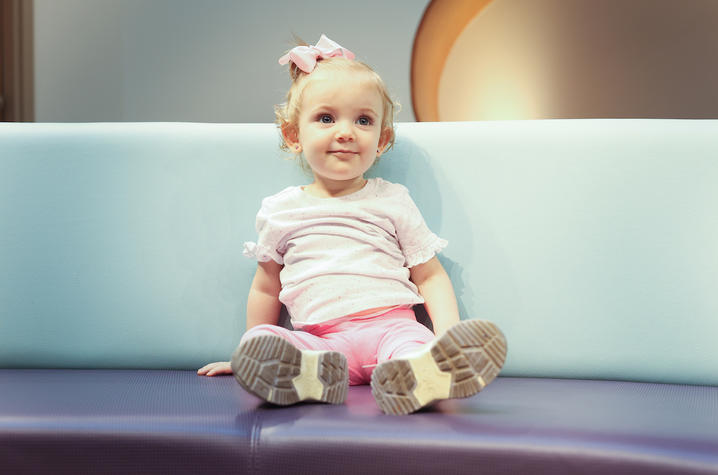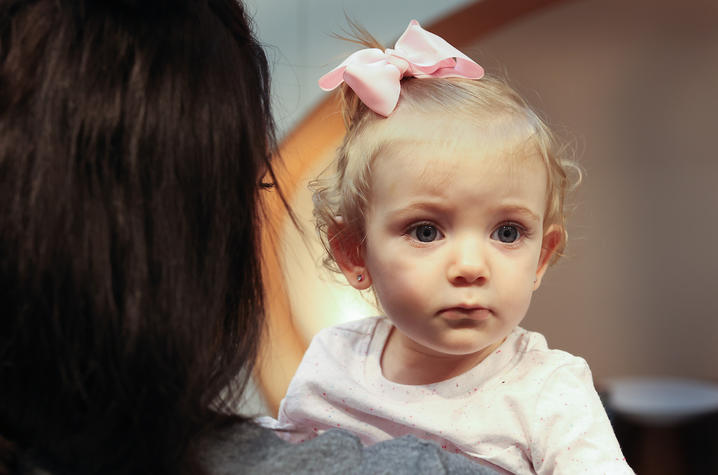KCH saves young patient from unusual, life-threatening disorder
LEXINGTON, Ky. (Aug. 19, 2022) — Kaitlin and Troy Clem were overjoyed to bring their fourth child, Maisyn, home on May 25, 2021, and begin the journey of raising their newborn. Everything seemed normal for the first several months of her life.
But, slowly, Maisyn’s parents began noticing that something was not quite right.
“She began choking each time she would drink or eat something of thin consistency, like water, breast milk or pureed baby food,” Kaitlin said. “She sounded constantly congested and nasally, and this progressed over the span of about four months. My daughter became very sick, and I knew something was wrong.”
Kaitlin and Troy took Maisyn to the pediatrician, and at first, they did not suspect anything was seriously wrong. But once they were referred to the Kentucky Children’s Hospital to participate in a swallow study, the pathologist began to see the issue. This was something unusual, and serious.
Maisyn was diagnosed with a rare, life-threatening condition called a tracheoesophageal fistula (TEF) type H. A fistula, or a small abnormal tube connecting one tubular organ to another, connected Maisyn’s trachea and esophagus together causing food and liquid contents to spill into her lungs every time she ate or drank. This type of TEF, type H, only occurs in about 4-5% of all tracheoesophageal anomalies.
Maisyn’s parents were in shock, and scared for her life, because this diagnosis meant that their child had been unknowingly aspirating liquids into her lungs since she was born — for almost an entire year of her life.
“I went into complete panic mode,” Kaitlin said. “Within three minutes of the completion of her swallow study, I was told that she needed to be admitted to the ED and they were not comfortable with her taking anything by mouth. They were calling in the pediatric ENT and the pediatric surgeon — I became completely hysterical.”
The realization that this was very serious quickly set in. Hour by hour, they were fighting.
“We finally knew why she had been coughing so much,” Kaitlin said. “But panic, worry, fear — every emotion possible went through both my husband and I in the very moment of her diagnosis.”
Once Maisyn was admitted, the 11-month-old soon went into a three-and-a-half-hour surgery with David J. Worhunsky, M.D., general and thoracic pediatric surgeon with the children’s hospital, and assistant professor of surgery at University of Kentucky College of Medicine. He entered through the side of Maisyn’s neck and closed the connection between her trachea and esophagus.
“This can be very difficult to diagnose, as it was in Maisyn’s case,” Worhunsky said. “In this case, it was making her very sick. She already showed signs of inflammation as a result of this fistula and had suffered multiple lung infections prior to surgery. In the OR, we were able to identify the connection, divide it, and close the two openings.”
But her fight continued, even after the surgery was complete.
“Because our daughter had been aspirating liquids into her lungs her whole life, she had trouble breathing during surgery,” Kaitlin said. “Her lungs weren’t as good as they should have been, so the doctors had to intubate her and decided to keep her on a ventilator until she was healed.”
Maisyn was on a ventilator for a total of seven days, which was longer than they had expected.
“She had a bit of a rocky recovery and required respiratory support for longer than what would be typical, likely because of the spillage of esophageal contents into her airway and lungs,” Worhunsky said. “But, once she turned the corner, Maisyn’s recovery was quite speedy and impressive.”
Kaitlin describes this week as one of the most challenging times of their lives.
“Those seven days were terrifying,” Kaitlin said. “And we were exhausted. Between her father and I, one of us was always there with her, and we were often there together. We are from Winchester, Kentucky, and we have three other children at home, so we had a lot of help from family at the time.”
Because they live out of town, they also received a room at Lexington’s Ronald McDonald House to support them while Maisyn was in recovery. And when Maisyn was discharged, they were thrilled to have their baby home.
“When she was discharged, we were so excited,” Kaitlin said. “She didn’t have many restrictions besides for thickening her food and liquids. The thickener we added helped her tolerate liquids better when swallowing.”
Now, Maisyn is happy and healthy. Doctors are continuing to monitor her swallowing and ensuring that Maisyn has no other anomalies in her body, as one anomaly increases her chances of having others. But, as of now, they do not believe that Maisyn will need any other surgeries, and she has since been moved off liquid thickeners.
“Her swallowing is much better now,” Kaitlin said. “She coughs sometimes still when drinking, but it is nothing like it was. She has gained nearly two pounds since her discharge and her voice is back and louder than ever — which we love. She is truly doing amazing.”
Kaitlin says that the care Maisyn received through Kentucky Children’s was so stellar, it inspired her to shift her career path. She plans to enter a nursing program next fall with the goal of becoming a pediatric care nurse so she can help other children in need like Maisyn.
“We just could not have done it without them,” Kaitlin said. “They treated us with such care and kindness during one of the most difficult moments in our lives, and I just want to be able to give back in the same way they do. That’s why I’m heading into a nursing program next fall, and I want to go into pediatrics. It just feels like this is what I’m supposed to do.”
Kaitlin and her husband will be forever grateful for the care team that helped their daughter return home safe and healthy.
“The pediatric ICU staff, speech pathology, pediatric surgery, pediatric ENT, respiratory therapy, child life, the chaplains, our employers, our friends and family, and the Ronald McDonald House. Thank you all,” Kaitlin said. “Without every single one of these people, we would not have survived.”
Worhunsky wants it to be noted that this was a true team effort — from many facets of UK HealthCare.
“This success is a result of the outstanding multidisciplinary care we offer at Kentucky Children’s,” Worhunsky said. “From our speech and language pathologist, Kaitlyn Minchin, to Dr. Azbell and his pediatric ENT team, to our operating room team including Dr. Weaver of pediatric anesthesia, and to Dr. Nelson and the entire pediatric ICU team that cared for Maisyn. I think Maisyn’s case was a wonderful example of the complex care we can provide at KCH — with outstanding outcomes. As we say in pediatric surgery, we don’t just strive to save lives, but to save lifetimes.”
As the state’s flagship, land-grant institution, the University of Kentucky exists to advance the Commonwealth. We do that by preparing the next generation of leaders — placing students at the heart of everything we do — and transforming the lives of Kentuckians through education, research and creative work, service and health care. We pride ourselves on being a catalyst for breakthroughs and a force for healing, a place where ingenuity unfolds. It's all made possible by our people — visionaries, disruptors and pioneers — who make up 200 academic programs, a $476.5 million research and development enterprise and a world-class medical center, all on one campus.






